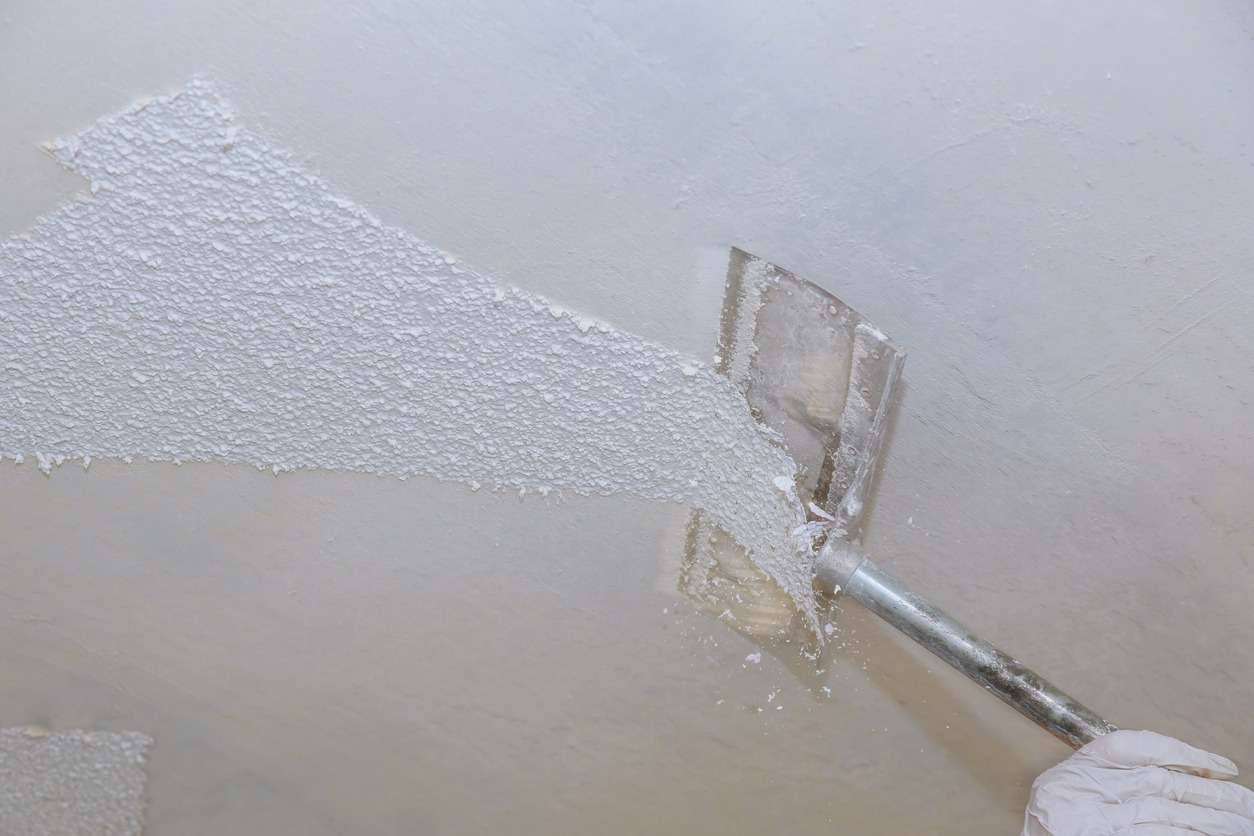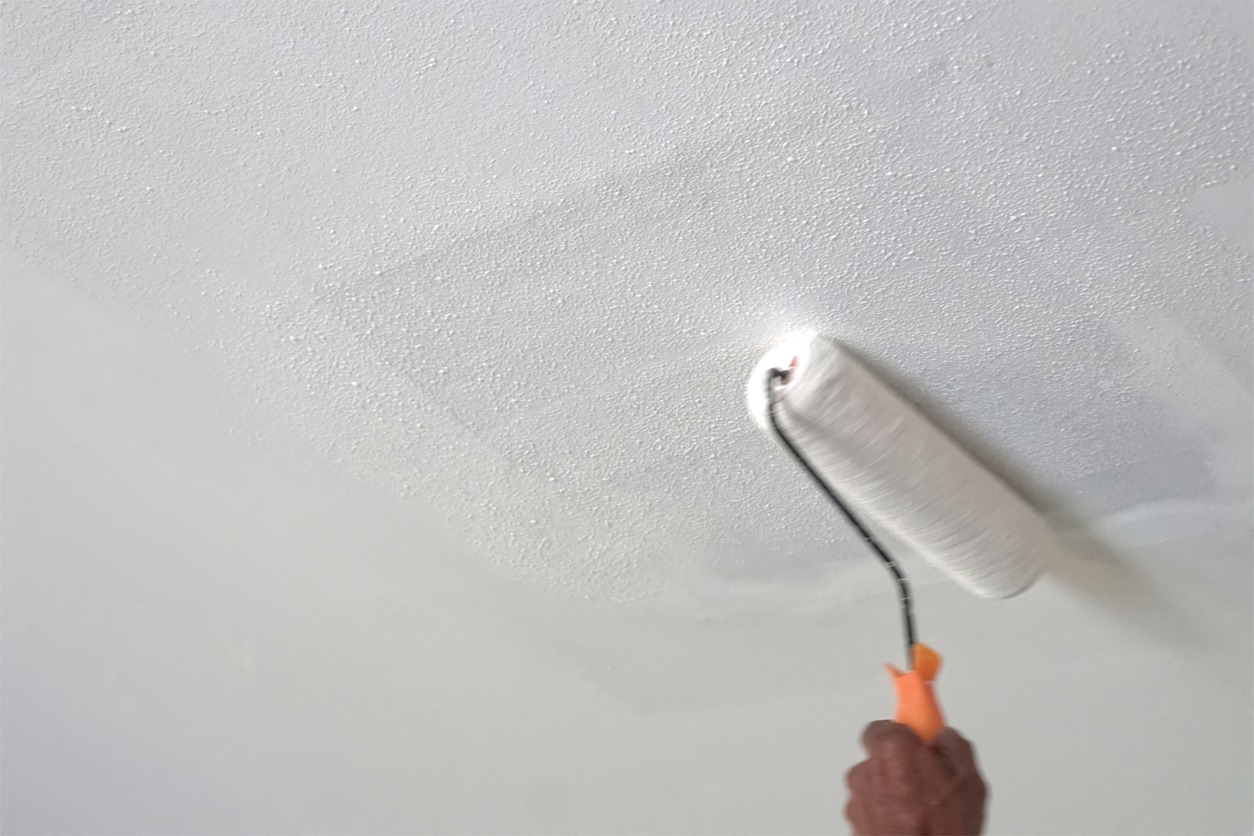Popcorn ceilings were once a popular choice for home interiors, but they have since fallen out of favor. As homeowners consider updating their spaces, they often face the decision of whether to paint over the textured surface or remove it altogether. This article examines the pros and cons of each option from the perspective of commercial painters.
The Disadvantages of Popcorn Ceilings
Popcorn ceilings, once popular for their sound-absorbing qualities, have become less desirable over time. Many homeowners now consider them outdated and impractical. Below are some of the main disadvantages of popcorn ceilings:
- Difficult to Clean: The textured surface makes it challenging to remove dust and cobwebs.
- Asbestos Risk: Older popcorn ceilings may contain asbestos, posing health risks if disturbed.
- Outdated Appearance: The style is often seen as outdated, making it less appealing in modern home design.
- Lighting Issues: The texture can create uneven shadows, affecting the quality of light in a room.
- Repair Challenges: Any damage to the ceiling is hard to repair without leaving noticeable patches.
Is It Recommended to Remove Popcorn Ceilings?
Many homeowners wonder if removing popcorn ceilings is a good idea. The answer often depends on the age of the home and personal preferences. For homes built before the 1980s, there is a risk that the ceiling may contain asbestos. In these cases, removal should be handled by professionals to avoid health hazards.
For newer homes, the decision is more about aesthetics and maintenance. Removing the textured surface can give a room a more modern look and make it easier to clean. However, it is a messy and labor-intensive process, so some might opt for painting over the texture instead.
Ultimately, the choice comes down to weighing the benefits of a cleaner and updated look against the effort and cost involved in removal.
Would It Be Better to Paint Over Popcorn Ceilings?
Painting over popcorn ceilings is a viable option for those looking to update their space without the mess of removal. It is a simpler and less time-consuming process, making it an attractive choice for many homeowners. By applying a fresh coat of paint, you can refresh the look of a room while keeping the textured ceiling intact.
However, some considerations must be made. Painting over popcorn ceilings may not be suitable if the texture is damaged or if the ceiling contains asbestos, which requires special handling.
Additionally, the texture may soak up more paint, requiring additional coats for even coverage. While this approach can improve the ceiling’s appearance, it won’t completely modernize the look, as the texture will still be visible.
How Do You Remove Popcorn Ceilings?
Removing popcorn ceilings is a task that requires careful preparation and execution. It’s a messy job, but with the right tools and steps, you can achieve a clean, modern ceiling. Here’s a step-by-step guide to help you through the process.
Preparation
Before starting, you need to prepare the room. Remove all furniture and cover the floors with plastic sheeting. This protects surfaces from debris and mess. You should also wear protective gear, including a mask and goggles, to avoid inhaling dust or irritants.
Testing for Asbestos
If your home was built before the 1980s, it’s essential to test the ceiling for asbestos. Asbestos is commonly used in building materials and can be hazardous when disturbed. You can purchase a test kit or hire a professional for this step. If asbestos is found, do not proceed with removal on your own; instead, hire a certified professional.
Wetting the Ceiling
Wetting the ceiling helps to loosen the popcorn texture, making it easier to remove. Use a garden sprayer to lightly mist the ceiling with water. Be careful not to oversaturate, as too much water can damage the drywall underneath. Let the water soak in for about 15 minutes before proceeding to the next step.
Scraping
Once the ceiling is damp, begin scraping off the texture with a wide putty knife or a ceiling scraper. Start in a small, inconspicuous area to get a feel for the process. Work in sections, gently scraping away the texture. Hold the scraper at a slight angle to avoid gouging the drywall.
Sanding and Smoothing
After the popcorn texture is removed, the ceiling may feel rough. Use fine-grit sandpaper to smooth out any remaining rough spots. This step helps to prepare the surface for priming and painting. Be sure to vacuum up all dust and debris once sanding is complete.
Priming and Painting
The final step is priming and painting the ceiling. Apply a primer to seal the drywall and provide a good base for paint. Once the primer is dry, apply two coats of paint for a clean and finished look. This step not only enhances the appearance but also helps to protect the ceiling.
Should You Hire Professionals to Remove Popcorn Ceilings?
Deciding whether to hire professionals to remove popcorn ceilings depends on several factors. One of the most important considerations is the presence of asbestos.
If your home was built before the 1980s, there’s a risk that the ceiling could contain this hazardous material. In such cases, hiring certified professionals is essential to safely handle and remove asbestos, protect your health, and ensure proper disposal.
Another factor to consider is the scope of the job. Removing popcorn ceilings is messy and labor-intensive. It involves moving furniture, covering surfaces, wetting the ceiling, scraping, and potentially repairing any damage.
Professional contractors have the experience and equipment to complete the job efficiently and with minimal mess. They can also handle any unexpected issues, such as repairing drywall or fixing electrical wiring.
While hiring professionals adds to the cost, it can save you time and hassle, especially if you’re not experienced with DIY projects.
Finding the Right Professionals for the Job
Choosing the right professionals to remove your popcorn ceilings is crucial for a smooth and successful project. With so many contractors available, it’s important to make an informed decision. Below are tips to help you find the right professionals for the job:
- Check for Licenses and Insurance: Make sure the contractor is licensed and insured. This protects you in case of accidents or damage during the project.
- Ask for References: Request references from previous clients. This helps you gauge the quality of the contractor’s work and their professionalism.
- Get Multiple Quotes: Obtain quotes from at least three different contractors. This allows you to compare prices and services offered.
- Review Their Experience: Look for contractors with experience in removing popcorn ceilings. Specialized experience ensures they understand the specific challenges of the job.
- Verify Asbestos Certification: If your home is older, check that the contractor is certified to handle asbestos. This is crucial for safety when dealing with potentially hazardous materials.
- Read Reviews and Testimonials: Online reviews and testimonials provide insight into the contractor’s reputation. Look for consistent feedback about the quality of work and customer service.
- Discuss the Process: Talk with the contractor about their approach to the job. A detailed explanation of their process and timeline shows they are thorough and transparent.
Conclusion
Deciding whether to paint or remove popcorn ceilings depends on various factors, including the age of the home, the presence of asbestos, and personal preferences.
Commercial painters often recommend removal for a more modern look and easier maintenance, but painting is a simpler and less expensive option. The choice ultimately comes down to your goals for your space and the resources you’re willing to commit.
If you need expert help with popcorn ceiling removal or painting, contact Custom Painting, Inc.. You can reach us at 925-294-8062 or fill out a Contact Form for more information.



